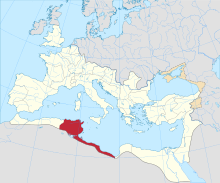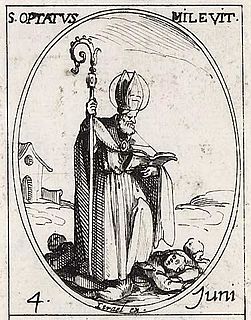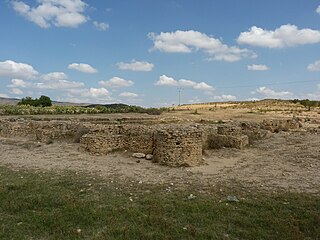
Melzi was a civitas (town) of the Roman Empire during late antiquity. It was also known as Meditanus. [1] [2]

In the history of Rome, the Latin term civitas, according to Cicero in the time of the late Roman Republic, was the social body of the cives, or citizens, united by law. It is the law that binds them together, giving them responsibilities (munera) on the one hand and rights of citizenship on the other. The agreement (concilium) has a life of its own, creating a res publica or "public entity", into which individuals are born or accepted, and from which they die or are ejected. The civitas is not just the collective body of all the citizens, it is the contract binding them all together, because each of them is a civis.

The Roman Empire was the post-Roman Republic period of the ancient Roman civilization. Ruled by emperors, it had large territorial holdings around the Mediterranean Sea in Europe, North Africa, the Middle East, and the Caucasus. From the constitutional reforms of Augustus to the military anarchy of the third century, the Empire was a principate ruled from the city of Rome. The Roman Empire was then ruled by multiple emperors and divided in a Western Roman Empire, based in Milan and later Ravenna, and an Eastern Roman Empire, based in Nicomedia and later Constantinople. Rome remained the nominal capital of both parts until 476 AD, when Odoacer deposed Romulus Augustus after capturing Ravenna and the Roman Senate sent the imperial regalia to Constantinople. The fall of the Western Roman Empire to barbarian kings, along with the hellenization of the Eastern Roman Empire into the Byzantine Empire, is conventionally used to mark the end of Ancient Rome and the beginning of the Middle Ages.

Late antiquity is a periodization used by historians to describe the time of transition from classical antiquity to the Middle Ages in mainland Europe, the Mediterranean world, and the Near East. The popularization of this periodization in English has generally been accredited to historian Peter Brown, after the publication of his seminal work The World of Late Antiquity (1971). Precise boundaries for the period are a continuing matter of debate, but Brown proposes a period between the 3rd and 8th centuries AD. Generally, it can be thought of as from the end of the Roman Empire's Crisis of the Third Century to, in the East, the early Muslim conquests in the mid-7th century. In the West the end was earlier, with the start of the Early Middle Ages typically placed in the 6th century, or earlier on the edges of the Western Roman Empire.
The town was in the Medjerda River valley of northern Tunisia. It was a civitas of the Roman province of Africa Proconsularis, [3] And the town has been tentatively identified with ruins at the Oued-Melzi Wadi and the Bagrada river confluence. [4] [5]

The Medjerda River, the classical Bagrada, is a river in North Africa flowing from northeast Algeria through Tunisia before emptying into the Gulf of Tunis and Lake of Tunis. With a length of 450 km (280 mi), it is the longest river of Tunisia. It is also known as the Wadi Majardah or Mejerha.

The Tunisian Sahel or more precisely the Central East Tunisia Region is an area of Central eastern Tunisia and a one of the Six Tunisian Regions. It stretches along the eastern shore, from Hammamet in the north to Mahdia in the south, including the governorates of Monastir, Mahdia, Sfax, and Sousse. Its name derives from the Arabic word sāḥil (ساحل), meaning "shore" or "coast". The regions' economy is based especially on tourism and it contains the second biggest airport in Tunisia: Monastir Habib Bourguiba International Airport.

The Roman provinces were the lands and people outside of Rome itself that were controlled by the Republic and later the Empire. Each province was ruled by a Roman who was appointed as governor. Although different in many ways, they were similar to the states in Australia or the United States, the regions in the United kingdom or New Zealand, or the prefectures in Japan. Canada refers to some of its territory as provinces.
In antiquity the town was also the seat of a Christian bishopric, [6] [7] suffragan of the Archdiocese of Carthage. [8] [9] [10]

Classical antiquity is the period of cultural history between the 8th century BC and the 5th or 6th century AD centered on the Mediterranean Sea, comprising the interlocking civilizations of ancient Greece and ancient Rome known as the Greco-Roman world. It is the period in which Greek and Roman society flourished and wielded great influence throughout Europe, North Africa and Western Asia.

A cathedra or bishop's throne is the seat of a bishop. It is a symbol of the bishop's teaching authority in the Catholic Church, the Orthodox Church, and the Anglican Communion churches. Cathedra is the Latin word for a chair with armrests, and it appears in early Christian literature in the phrase "cathedrae apostolorum", indicating authority derived directly from the apostles; its Roman connotations of authority reserved for the Emperor were later adopted by bishops after the 4th century. A church into which a bishop's official cathedra is installed is called a cathedral.
There are two documented bishops of this African dioceses.
- Valerio was convicted, along with other supporters of the Donatist bishops Maximian, in the Donatist Council of Bagai of 394. [11] [12] [13]
- The Catholic bishop Tutus, who participated in the Council of Carthage of 411, (the town had no Donatist bishops at that time). Tutus himself was present with two other councils of Carthage, celebrated in 416 and 424.
Maximian was a 4th-century Bishop of Carthage and founder of a splinter group that left Donatism.
The town was mentioned by Augustine [14] and Optatus [15]

Saint Augustine of Hippo was a Roman African, early Christian theologian and philosopher from Numidia whose writings influenced the development of Western Christianity and Western philosophy. He was the bishop of Hippo Regius in north Africa and is viewed as one of the most important Church Fathers in Western Christianity for his writings in the Patristic Period. Among his most important works are The City of God, De doctrina Christiana and Confessions.

Saint Optatus, sometimes anglicized as St. Optate, was Bishop of Milevis, in Numidia, in the fourth century, remembered for his writings against Donatism.



